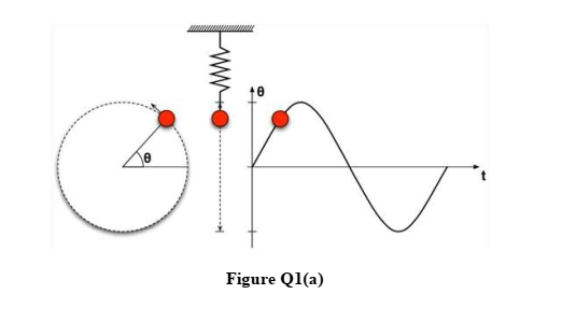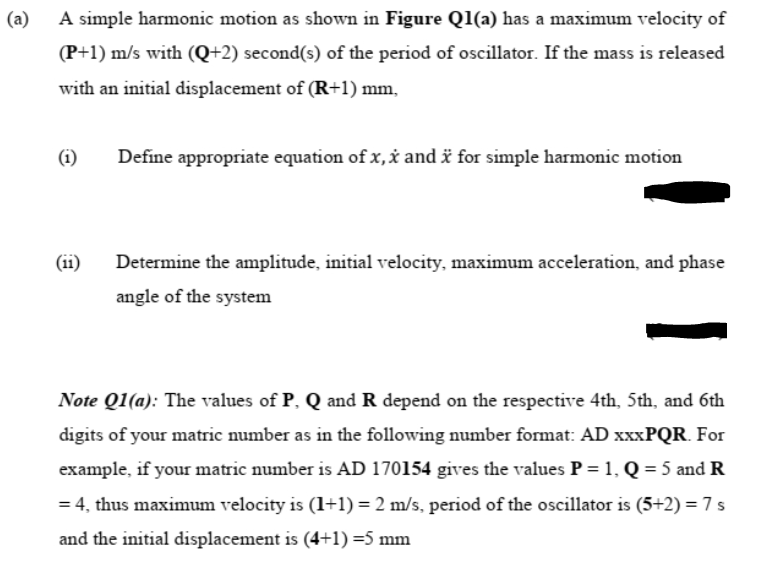(a) A simple harmonic motion as shown in Figure Q1(a) has a maximum velocity of (P+1) m/s with (Q+2) second(s) of the period of oscillator. If the mass is released with an initial displacement of (R+1) mm, (i) Define appropriate equation of x, i and ë for simple harmonic motion (ii) Determine the amplitude, initial velocity, maximum acceleration, and phase angle of the system
(a) A simple harmonic motion as shown in Figure Q1(a) has a maximum velocity of (P+1) m/s with (Q+2) second(s) of the period of oscillator. If the mass is released with an initial displacement of (R+1) mm, (i) Define appropriate equation of x, i and ë for simple harmonic motion (ii) Determine the amplitude, initial velocity, maximum acceleration, and phase angle of the system
Elements Of Electromagnetics
7th Edition
ISBN:9780190698614
Author:Sadiku, Matthew N. O.
Publisher:Sadiku, Matthew N. O.
ChapterMA: Math Assessment
Section: Chapter Questions
Problem 1.1MA
Related questions
Question
subject (vibration)
pls use this matrix num sir ( AD 200153)

Transcribed Image Text:Figure Q1(a)

Transcribed Image Text:(a)
A simple harmonic motion as shown in Figure Q1(a) has a maximum velocity of
(P+1) m/s with (Q+2) second(s) of the period of oscillator. If the mass is released
with an initial displacement of (R+1) mm,
(i)
Define appropriate equation of x,x and ä for simple harmonic motion
(ii)
Determine the amplitude, initial velocity, maximum acceleration, and phase
angle of the system
Note Q1(a): The values of P, Q and R depend on the respective 4th, 5th, and 6th
digits of your matric number as in the following number format: AD XXXPQR. For
example, if your matric number is AD 170154 gives the values P = 1, Q = 5 and R
= 4, thus maximum velocity is (1+1) = 2 m/s, period of the oscillator is (5+2) = 7 s
and the initial displacement is (4+1) =5 mm
Expert Solution
This question has been solved!
Explore an expertly crafted, step-by-step solution for a thorough understanding of key concepts.
Step by step
Solved in 5 steps

Knowledge Booster
Learn more about
Need a deep-dive on the concept behind this application? Look no further. Learn more about this topic, mechanical-engineering and related others by exploring similar questions and additional content below.Recommended textbooks for you

Elements Of Electromagnetics
Mechanical Engineering
ISBN:
9780190698614
Author:
Sadiku, Matthew N. O.
Publisher:
Oxford University Press

Mechanics of Materials (10th Edition)
Mechanical Engineering
ISBN:
9780134319650
Author:
Russell C. Hibbeler
Publisher:
PEARSON

Thermodynamics: An Engineering Approach
Mechanical Engineering
ISBN:
9781259822674
Author:
Yunus A. Cengel Dr., Michael A. Boles
Publisher:
McGraw-Hill Education

Elements Of Electromagnetics
Mechanical Engineering
ISBN:
9780190698614
Author:
Sadiku, Matthew N. O.
Publisher:
Oxford University Press

Mechanics of Materials (10th Edition)
Mechanical Engineering
ISBN:
9780134319650
Author:
Russell C. Hibbeler
Publisher:
PEARSON

Thermodynamics: An Engineering Approach
Mechanical Engineering
ISBN:
9781259822674
Author:
Yunus A. Cengel Dr., Michael A. Boles
Publisher:
McGraw-Hill Education

Control Systems Engineering
Mechanical Engineering
ISBN:
9781118170519
Author:
Norman S. Nise
Publisher:
WILEY

Mechanics of Materials (MindTap Course List)
Mechanical Engineering
ISBN:
9781337093347
Author:
Barry J. Goodno, James M. Gere
Publisher:
Cengage Learning

Engineering Mechanics: Statics
Mechanical Engineering
ISBN:
9781118807330
Author:
James L. Meriam, L. G. Kraige, J. N. Bolton
Publisher:
WILEY